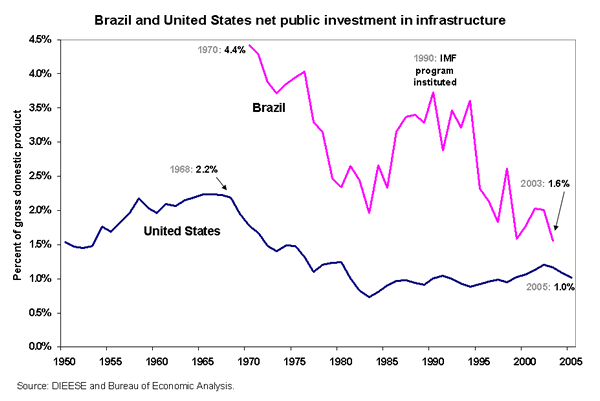See Snapshots archive.
Snapshot for August 14, 2007.
Infrastructure cuts and consequences
by Tony Avirgan with research assistance from Ricardo Franzoi (DIEESE) and Lauren Marra
The recent tragedies of the collapse of the Interstate-35 bridge in Minneapolis and the crash of an Airbus A320 at Congonha Airport in Sao Paulo, Brazil have two things in common: both pieces of infrastructure had been identified as potentially dangerous and their repair or replacement had been put off as governments chose to spend shrinking resources on other priorities.
The sharp reduction in Brazil’s infrastructure spending corresponds with the institution of an International Monetary Fund (IMF) program in 1999.1 The IMF demanded a 20% reduction in government spending that year. Government spending has remained low since then and plans to replace the aging airport were put off indefinitely. Brazil’s executive director to the IMF warned three years ago of dire consequences if Brazil did not break from the IMF regimen and increase spending on infrastructure.2 Only now that 200 people have died has a new airport become an urgent priority.
Infrastructure spending in the United States has also declined as a share of GDP from its peak in the late 1960s (see Chart ). This neglect stems from the increased political difficulty of generating public investment revenue by raising taxes. The federal tax on gasoline—the main source of federal highway funds—has not risen in 14 years. Two years ago, Congress proposed a four-cents-per-gallon boost in the fuel tax that would have financed a $375 billion, five-year highway bill. President Bush threatened to veto any highway bill that included a tax increase and Congress backed off, instead presenting a $286 billion spending plan.

The American Society of Civil Engineers estimates the cost of repairing or replacing obsolete or deteriorating bridges at $7.4 billion per year. This year’s appropriations bill provides slightly less than $4 billion for such infrastructure maintenance, leaving many U.S. roadways in a state of disrepair, and drivers wondering about the safety of their daily commute.
Notes
1. Brazil Letter of Intent www.imf.org/external/np/loi/111398.htm .
2. Dr. Paulo Noguira Batista, Jr. “Aumentar o superavit primario?” Folha de Sao Paulo. Sept. 23, 2004.
